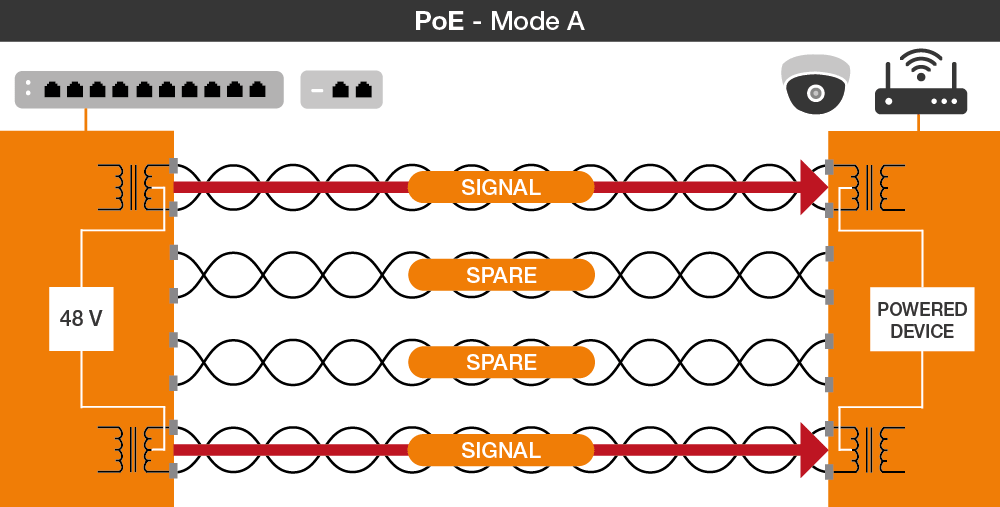PoE – power via a network cable

Power Over Ethernet (PoE) is a function that makes it possible to transmit electrical power as well as data via an Ethernet cable. The advantages are considerable as an additional cable for power supply is not necessary. Devices such as WiFi access points and IP web cams can therefore be connected to the infrastructure and supplied with energy by means of a single cable*.
If you are wondering why we use the term “Ethernet cable” instead of network cable: we explain this in another article.
Application areas
Power over Ethernet is used in many areas. For instance, a wireless network infrastructure can be set up with PoE without a separate power supply for the access points, routers or repeaters.
Security cameras can also be integrated into the system faster. Especially for temporary solutions such as on building sites, this is very advantageous. Entire alarm systems can be connected and supplied with power in this way.
In hollow walls or ceilings in which it is difficult to install power supply cables, smaller loads can be supplied with power via a thin network cable.
The technology underlying PoE
The power is delivered by a power supplier. This is done via a PoE-capable router or switch across which a voltage is applied. Existing devices can continue to be used. In this case, a so-called PoE injector would be used and integrated between the existing switch or router and the device to be supplied. The injector continues to let data through unhindered and “injects” the current into the Ethernet cable. Such devices are called power sourcing equipment (PSE), whereas power-consuming loads are called “powered devices” (PD).
The devices can work in two modes – A mode and B mode:
A mode
In A mode, power transmission takes place via the same wires that carry data.

How is that possible?
Data are transmitted in the conductor without the application of direct voltage. If a direct voltage is now applied, the signal can continue to be transmitted. At the load, the direct voltage component of the mixed signal is now uncoupled from the data.
B mode
For different applications and for possible future needs, Ethernet cables have two additional wire pairs. These can also be used for power transmission.

All standards at a glance
PoE (802.3af)
Published in 2003, the standard makes power of approximately 12.95 W available to the end-consumer. In this regard, there is often talk of around 15 W as the value – however, this is the power that is fed into the system. As a result of transmission, power losses occur; this explains the difference.
In the meantime, PoE is not the only standard that exists; there are also two newer, more powerful standards.
PoE+ (802.3at)
PoE+ supports up to two loads (PDs) at the same time with a total power of approximately 25.5 W.
PoE++ (802.3bt)
The latest standard, also called 4-pair PoE in addition to PoE++, transmits current via all four wire pairs and not just via two. We thus have power levels of between 70 and 100 watts that arrive at the load.
Disadvantage of the technology
CAT-5, CAT-6 and CAT-7 network cables consist of eight thin wires, which are also completely adequate for data transmission at a rate of 10 Gbps in some cases. Due to their small cross-section, however, the wires have a high degree of resistance, which leads to losses, especially where longer transmission routes are involved. Efficiency levels of only 70% are possible in this case.
Conclusion
PoE is highly advantageous for many applications. Due to PoE, many devices no longer need any further power supply and this makes installation and maintenance easier. The technology can also be retrofitted where network cables have already been laid. This can be done by means of an injector, router or switch. Unfortunately, energy is lost in the form of heat but this is negligible in the case of low power levels.
However, before you lay new network cables, we recommend that you read our article on different CAT standards.

S.cornelius
I've definitely learnt a lot more than I thought I would about ethernet cables; I recently had one installed and was interested in reading up on them. I wouldn't have thought a whole alarm system could be installed through ethernet cables. thank you for sharing!